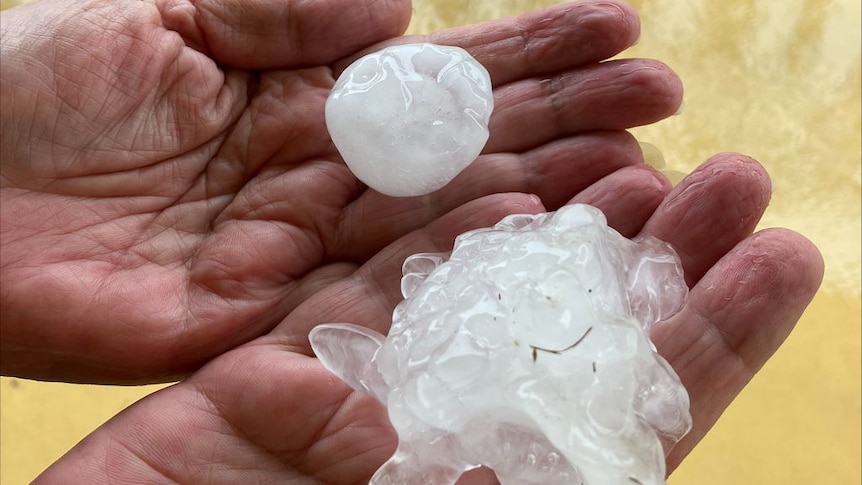Australia Weather News

Large hailstones fall onto a lawn near Grafton, NSW. (ABC News)
Has your city or town been experiencing more hailstorms?
Have hailstones been getting larger, or does social media just make it feel that way?
The answer could be a mix of the two.
Joshua Soderholm, a research scientist at the Bureau of Meteorology, says the criteria for the formation of hail remains the same, but there is research to suggest a shift in where, and how often, hailstorms have been occurring.
For hailstones to form, hot, humid conditions are ideal and they're created in the "very deep clouds" of a storm.
Giant-sized hail always have something in common.
"Particularly the more extreme sizes, they are always from a supercell thunderstorm," Dr Soderholm says.
He says supercells are special for a few reasons, but for hail, it is the longevity of the storms that make a difference.
"A general storm might only last half an hour or so, but supercells tend to last a lot longer, and in doing so they also become a lot more intense," Dr Soderholm says.
"This allows hail to stay up in the cloud for longer and grow bigger before falling back down to the surface."
Weirdly shaped hail
Dr Soderholm says unusual shapes of hail are formed much like an icicle.
Water runs along the surface of hailstones while they're forming in the supercooled heights of storm clouds.
"We see these shapes like stars, ninja stars, starfish, insect shapes, all these sorts of weird shapes," he says.
"Where you have water running across the hailstone staying liquid, then it moves to a certain point and it freezes there.
"Lots of water drops follow and keep growing in the same direction, just like an icicle might form under a building where water is dripping in the same place.
"That leads to these very 'lobey' hailstones."
Dr Soderholm says every hailstone is unique.
"They could be moving at well over 100 kilometres per hour up in the clouds," he says.
"You get these incredibly complex shapes because each one is tumbling a different way, it's collecting water a different way and the icicles are growing a different way."
When it comes to hail damage, the focus can be on giant hail, but jagged stones pose different risks.
"Some damage, say to roof tiles or to cars, is more related to the mass of the hailstone," Dr Soderholm says.
"These jagged hailstones can do more damage to crops, to livestock animals outdoor and people who are outdoors."
Hail's shifting footprint
Research suggests the way hail impacts on different parts of Australia has been changing.
"There is a huge amount of year-to-year variability," Dr Soderholm says.
"For example, the city of Brisbane gets a lot of hailstorms, but there will be many years in a row where it gets none.
"And then there will be a year where it gets everything all at once, so this variability is very common.
"But there is also an underlying trend that has been going on.
"We have looked at … some recent research led by Tim Raupach at the University of NSW, and we found that the time of year hail occurs is changing across Australia, and also the total number of hailstorms has a trend as well.
"Places like Sydney, Canberra, that part of the country, are seeing more hailstorm days.
"Places which get a lot of hail on the other hand, like Brisbane, are actually starting to see a slight decrease in the number of hailstorm days."
Dr Soderholm says this is linked to a shift in the conditions that support hailstorms.
"These conditions are … moving, with the changing climate, across Australia."
"They're moving further south."
Is hail getting bigger?
Dr Soderholm says social media has contributed a lot to that feeling.
"It's a bit difficult to say whether the hail is getting bigger in some locations versus others.
"We have a lot more confidence in saying some regions are now more hail prone than they used to be.
"We see that in the science, but also obviously when you look at Facebook now, you can see hail photos from the middle of the country and you never would have seen that, 10 years ago, 20 years ago."
NRMA Insurance releases a quarterly Wild Weather Tracker report with details of extreme weather events.
Hail damage accounted for about 20 per cent of total extreme weather claims recorded by the insurer from spring 2024.
"Because hail forms rapidly, it has the potential to cause concentrated and significant damage," an NRMA spokesperson says.
"There is often little advance warning for communities that a hailstorm is forming, leaving people unprepared and vulnerable to significant damage to their vehicles and properties."
The hailstorms that battered Sydney in December 2018 were a historic peak in damages.
ABC